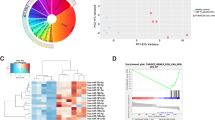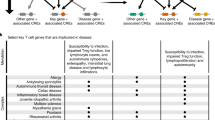Abstract
Owing to their manifold immune regulatory functions, regulatory T cells (Treg) have received tremendous interest as targets for therapeutic intervention of diverse immunological pathologies or cancer. Directed manipulation of Treg will only be achievable with extensive knowledge about the intrinsic programs that define their regulatory function. We simultaneously analyzed miR and mRNA transcript levels in resting and activated human Treg cells in comparison with non-regulatory conventional T cells (Tcon). Based on experimentally validated miR-target information, both transcript levels were integrated into a comprehensive pathway analysis. This strategy revealed characteristic signal transduction pathways involved in Treg biology such as T-cell receptor-, Toll-like receptor-, transforming growth factor-β-, JAK/STAT (Janus kinase/signal transducers and activators of transcription)- and mammalian target of rapamycin signaling, and allowed for the prediction of specific pathway activities on the basis of miR and mRNA transcript levels in a probabilistic manner. These data encourage new concepts for targeted control of Treg cell effector functions.
This is a preview of subscription content, access via your institution
Access options
Subscribe to this journal
Receive 6 digital issues and online access to articles
$119.00 per year
only $19.83 per issue
Buy this article
- Purchase on Springer Link
- Instant access to full article PDF
Prices may be subject to local taxes which are calculated during checkout






Similar content being viewed by others
Accession codes
References
Sakaguchi S . Naturally arising CD4+ regulatory t cells for immunologic self-tolerance and negative control of immune responses. Annu Rev Immunol 2004; 22: 531–562.
Allan SE, Broady R, Gregori S, Himmel ME, Locke N, Roncarolo MG et al. CD4+ T-regulatory cells: toward therapy for human diseases. Immunol Rev 2008; 223: 391–421.
Torgerson TR, Ochs HD . Immune dysregulation, polyendocrinopathy, enteropathy, X-linked: forkhead box protein 3 mutations and lack of regulatory T cells. J Allergy Clin Immunol 2007; 120: 744–750.
Shen Z, Chen L, Hao F, Wu J . Transcriptional regulation of Foxp3 gene: multiple signal pathways on the road. Med Res Rev 2009; 29: 742–766.
Zhang L, Zhao Y . The regulation of Foxp3 expression in regulatory CD4(+)CD25(+)T cells: multiple pathways on the road. J Cell Physiol 2007; 211: 590–597.
Ha TY . The role of microRNAs in regulatory T cells and in the immune response. Immune Netw 2011; 11: 11–41.
Bartel DP . MicroRNAs: genomics, biogenesis, mechanism, and function. Cell 2004; 116: 281–297.
Chekulaeva M, Filipowicz W . Mechanisms of miRNA-mediated post-transcriptional regulation in animal cells. Curr Opin Cell Biol 2009; 21: 452–460.
Wightman B, Ha I, Ruvkun G . Posttranscriptional regulation of the heterochronic gene lin-14 by lin-4 mediates temporal pattern formation in C. elegans. Cell 1993; 75: 855–862.
De Santis G, Ferracin M, Biondani A, Caniatti L, Rosaria Tola M, Castellazzi M et al. Altered miRNA expression in T regulatory cells in course of multiple sclerosis. J Neuroimmunol 2010; 226: 165–171.
Fayyad-Kazan H, Rouas R, Fayyad-Kazan M, Badran R, El Zein N, Lewalle P et al. MicroRNA profile of circulating CD4-positive regulatory T cells in human adults and impact of differentially expressed microRNAs on expression of two genes essential to their function. J Biol Chem 2012; 287: 9910–9922.
Pfoertner S, Jeron A, Probst-Kepper M, Guzman CA, Hansen W, Westendorf AM et al. Signatures of human regulatory T cells: an encounter with old friends and new players. Genome Biol 2006; 7: R54.
Rouas R, Fayyad-Kazan H, El Zein N, Lewalle P, Rothe F, Simion A et al. Human natural Treg microRNA signature: role of microRNA-31 and microRNA-21 in FOXP3 expression. Eur J Immunol 2009; 39: 1608–1618.
Sadlon TJ, Wilkinson BG, Pederson S, Brown CY, Bresatz S, Gargett T et al. Genome-wide identification of human FOXP3 target genes in natural regulatory T cells. J Immunol 2010; 185: 1071–1081.
Birzele F, Fauti T, Stahl H, Lenter MC, Simon E, Knebel D et al. Next-generation insights into regulatory T cells: expression profiling and FoxP3 occupancy in Human. Nucleic Acids Res 2011; 39: 7946–7960.
Sugimoto N, Oida T, Hirota K, Nakamura K, Nomura T, Uchiyama T et al. Foxp3-dependent and -independent molecules specific for CD25+CD4+ natural regulatory T cells revealed by DNA microarray analysis. Int Immunol 2006; 18: 1197–1209.
Zheng Y, Josefowicz SZ, Kas A, Chu TT, Gavin MA, Rudensky AY . Genome-wide analysis of Foxp3 target genes in developing and mature regulatory T cells. Nature 2007; 445: 936–940.
Thornton AM, Piccirillo CA, Shevach EM . Activation requirements for the induction of CD4+CD25+ T cell suppressor function. Eur J Immunol 2004; 34: 366–376.
Huang da W, Sherman BT, Lempicki RA . Systematic and integrative analysis of large gene lists using DAVID bioinformatics resources. Nat Protoc 2009; 4: 44–57.
Ivanovska I, Cleary MA . Combinatorial microRNAs: working together to make a difference. Cell Cycle 2008; 7: 3137–3142.
Hsu SD, Lin FM, Wu WY, Liang C, Huang WC, Chan WL et al. miRTarBase: a database curates experimentally validated microRNA-target interactions. Nucleic Acids Res 2011; 39 (Database issue): D163–D169.
Huang da W, Sherman BT, Lempicki RA . Bioinformatics enrichment tools: paths toward the comprehensive functional analysis of large gene lists. Nucleic Acids Res 2009; 37: 1–13.
Viswanathan GA, Seto J, Patil S, Nudelman G, Sealfon SC . Getting started in biological pathway construction and analysis. PLoS Comput Biol 2008; 4: e16.
Magg T, Mannert J, Ellwart JW, Schmid I, Albert MH . Subcellular localization of FOXP3 in human regulatory and nonregulatory T cells. Eur J Immunol 2012; 42: 1627–1638.
Shalgi R, Brosh R, Oren M, Pilpel Y, Rotter V . Coupling transcriptional and post-transcriptional miRNA regulation in the control of cell fate. Aging (Albany NY) 2009; 1: 762–770.
Jeker LT, Zhou X, Gershberg K, de Kouchkovsky D, Morar MM, Stadthagen G et al. MicroRNA 10a marks regulatory T cells. PLoS One 2012; 7: e36684.
Cobb BS, Hertweck A, Smith J, O'Connor E, Graf D, Cook T et al. A role for Dicer in immune regulation. J Exp Med 2006; 203: 2519–2527.
Lu LF, Boldin MP, Chaudhry A, Lin LL, Taganov KD, Hanada T et al. Function of miR-146a in controlling Treg cell-mediated regulation of Th1 responses. Cell 2010; 142: 914–929.
Taganov KD, Boldin MP, Chang KJ, Baltimore D . NF-kappaB-dependent induction of microRNA miR-146, an inhibitor targeted to signaling proteins of innate immune responses. Proc Natl Acad Sci 2006; 103: 12481–12486.
Xu WD, Lu MM, Pan HF, Ye DQ . Association of MicroRNA-146a with autoimmune diseases. Inflammation 2012; 35: 1525–1529.
Tone Y, Furuuchi K, Kojima Y, Tykocinski ML, Greene MI, Tone M . Smad3 and NFAT cooperate to induce Foxp3 expression through its enhancer. Nat Immunol 2008; 9: 194–202.
Valastyan S, Reinhardt F, Benaich N, Calogrias D, Szasz AM, Wang ZC et al. A pleiotropically acting microRNA, miR-31, inhibits breast cancer metastasis. Cell 2009; 137: 1032–1046.
Jana S, Jailwala P, Haribhai D, Waukau J, Glisic S, Grossman W et al. The role of NF-kappaB and Smad3 in TGF-beta-mediated Foxp3 expression. Eur J Immunol 2009; 39: 2571–2583.
Crellin NK, Garcia RV, Hadisfar O, Allan SE, Steiner TS, Levings MK . Human CD4+ T cells express TLR5 and its ligand flagellin enhances the suppressive capacity and expression of FOXP3 in CD4+CD25+ T regulatory cells. J Immunol 2005; 175: 8051–8059.
Liu HY, Komai-Koma M, Xu D, Liew FY . Toll-like receptor 2 signaling modulates the functions of CD4(+)CD25(+) regulatory T cells. Proc Natl Acad Sci 2006; 103: 7048–7053.
Jiang S, Li C, Olive V, Lykken E, Feng F, Sevilla J et al. Molecular dissection of the miR-17-92 cluster's critical dual roles in promoting Th1 responses and preventing inducible Treg differentiation. Blood 2011; 118: 5487–5497.
Powell JD, Lerner CG, Schwartz RH . Inhibition of cell cycle progression by rapamycin induces T cell clonal anergy even in the presence of costimulation. J Immunol 1999; 162: 2775–2784.
Powell JD, Pollizzi KN, Heikamp EB, Horton MR . Regulation of immune responses by mTOR. Annu Rev Immunol 2012; 30: 39–68.
Sun J, Chen Z, Tan X, Zhou F, Tan F, Gao Y et al. MicroRNA-99a/100 promotes apoptosis by targeting mTOR in human esophageal squamous cell carcinoma. Med Oncol 2013; 30: 411.
Zhou L, Lopes JE, Chong MM, Ivanov II, Min R, Victora GD et al. TGF-beta-induced Foxp3 inhibits T(H)17 cell differentiation by antagonizing RORgammat function. Nature 2008; 453: 236–240.
Beyer M, Schultze JL . Plasticity of T(reg) cells: is reprogramming of T(reg) cells possible in the presence of FOXP3? Int Immunopharmacol 2011; 11: 555–560.
Walker MR, Kasprowicz DJ, Gersuk VH, Benard A, Van Landeghen M, Buckner JH et al. Induction of FoxP3 and acquisition of T regulatory activity by stimulated human CD4+CD25- T cells. J Clin Invest 2003; 112: 1437–1443.
von Boehmer H, Daniel C . Therapeutic opportunities for manipulating T(Reg) cells in autoimmunity and cancer. Nat Rev Drug Discov 2013; 12: 51–63.
Agarwal S, Amin KS, Jagadeesh S, Baishay G, Rao PG, Barua NC et al. Mahanine restores RASSF1A expression by down-regulating DNMT1 and DNMT3B in prostate cancer cells. Mol Cancer 2013; 12: 99.
Daniel C, Wennhold K, Kim HJ, von Boehmer H . Enhancement of antigen-specific Treg vaccination in vivo. Proc Natl Acad Sci USA 2010; 107: 16246–16251.
Sewgobind VD, Quaedackers ME, van der Laan LJ, Kraaijeveld R, Korevaar SS, Chan G et al. The Jak inhibitor CP-690,550 preserves the function of CD4CD25FoxP3 regulatory T cells and inhibits effector T cells. Am J Transplant 2010; 10: 1785–1795.
Bolstad BM, Irizarry RA, Astrand M, Speed TP . A comparison of normalization methods for high density oligonucleotide array data based on variance and bias. Bioinformatics 2003; 19: 185–193.
Edgar R, Domrachev M, Lash AE . Gene Expression Omnibus: NCBI gene expression and hybridization array data repository. Nucleic Acids Res 2002; 30: 207–210.
Gentleman R . Reproducible research: a bioinformatics case study. Stat Appl Genet Mol Biol 2005; 4: Article2.
Subramanian A, Tamayo P, Mootha VK, Mukherjee S, Ebert BL, Gillette MA et al. Gene set enrichment analysis: a knowledge-based approach for interpreting genome-wide expression profiles. Proc Natl Acad Sci USA 2005; 102: 15545–15550.
Acknowledgements
This project was supported in part by the Wilhelm-Sander-Stiftung and by the ‘Mehr LEBEN fuer krebskranke Kinder—Bettina—Braeu-Stiftung’ to MHA.
Author information
Authors and Affiliations
Corresponding author
Ethics declarations
Competing interests
The authors declare no conflict of interest.
Additional information
Supplementary Information accompanies this paper on Genes and Immunity website
Rights and permissions
About this article
Cite this article
Albert, M., Mannert, J., Fleischmann, K. et al. MiRNome and transcriptome aided pathway analysis in human regulatory T cells. Genes Immun 15, 303–312 (2014). https://doi.org/10.1038/gene.2014.20
Received:
Revised:
Accepted:
Published:
Issue Date:
DOI: https://doi.org/10.1038/gene.2014.20
This article is cited by
-
Construction of a predictive model for immunotherapy efficacy in lung squamous cell carcinoma based on the degree of tumor-infiltrating immune cells and molecular typing
Journal of Translational Medicine (2022)
-
Phenotypic characterisation of regulatory T cells in dogs reveals signature transcripts conserved in humans and mice
Scientific Reports (2019)
-
Lactic acid bacteria-specific induction of CD4+Foxp3+T cells ameliorates shrimp tropomyosin-induced allergic response in mice via suppression of mTOR signaling
Scientific Reports (2017)



